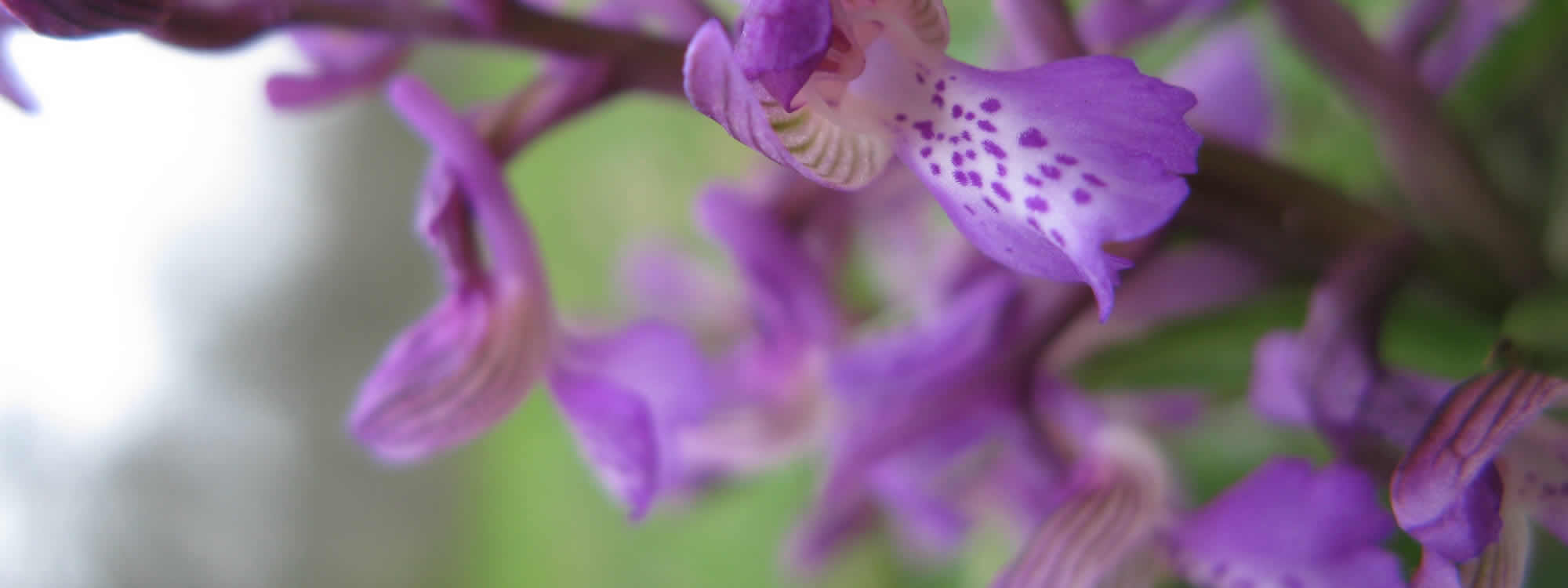The Northern Pindos National Park hosts more than 1800 flora species. Five species of the wild lily flourish in the area: the Madonna Lily (Lilium candidum), the red Lily (Lilium chalcedonicum), the lily of Cheldraich (Lilium heldraichi), the orange Turk’s cap lily (Lilium albanicum) and the Martagon or Turk’s cap lily (Lilium martagon).
Some other impressive flora species are the Poet’s Daffodil (Narcissus poeticus), the Australian tulip (tulipa australis), the spring gentian (Gentiana verna), the Houseleeks or Liveforever (Sempervivum marmoreum) and the Saxifraga spruneri.
Various medicinal herbs and plants flourish in the area, such as the mint (Mentha longifolia), the sage (Salvia officinalis), the Winter Savory (Satureja montana), the thyme (Thymus teucrioides) and the mountain tea (Sideritis raeseri) , the helleborus (Helleborus cyclophyllus), the daphne (Daphne oleoides), the willowherb (Epilobium alsinifolium), the conium (Conium maculatum), the myrtle spurge (Euphorbia deflexa), the danewort (Sambucus ebulus), the False Helleborine (Veratrum album) and many others.

The flora of the ophiolite rocks mountains (such as Mounts Smolikas, Vasilitsa, Ligos, Flambouro etc) is particularly interesting and it includes plants that are adjusted to heavy metal-rich soils, such as the Alysum smoliKanum, the Allium sphaerocephalon, the Viola albanica, the Galium ophiolithicum, the Cerastium smolikanum, the Centaurea ptarmicaefolia etc.
The Orchidaceae are a diverse and widespread family of flowering plants with colourful and fragrant blooms, commonly known as the orchid family. The orchids are widely found in valleys and several mountain peaks and slopes in the Park’s region: the Orchis mascula, the Orchis pallens, the Orchis ustulata, the Orchis coriophora, the Orchis laxiflora, the Orchis proνincialis, the Orchis pauciflora, the Orchis papilionacea, the Orchis quadripunctata, the Orchis morio, the Orchis tridentata, the Orchis purpurea, the Orcis italica, the Orchis simia, the Orchis pyramidalis, the Dactylorhiza saccifera, the dactylorhiza sabucina, the dactylorhiza kalopissii, the Dactylorhiza baumanniana, Dactylorrhiza maculate, etc.
The National Park hosts a large number of rare, endemic and endangered species, such as: the Tymfi’s centaureio (Centaurea tymphaea), the Centaurea vlachorum, the Sedυm tymphaeυm, the Pavlov’s centaureio (Centaurea pawlowskii), the Tymfi’s centaurea bommuelleri (Bommuellera tymphaea), the netted Iris (Alyssum heldreichi), the Silene pindicola, the Onosma epirotica, the Minυartia pseυdosaxifraga, the lilies (Valeriana crinii epirotica), the Pindos snowbells (Soldanella pindicola), the Saxifraga biflora-epirotica, the Galiυm sacrorυm, the Hieraciυm dasycraspedυm, etc.
Other remarkable species with limited geographical distribution in the National Park area are the Serbian ramonda (Ramonda serbica), the Pingυicυlla crystalline ssp hirtiflora, the iris (lris sindenisii janka) etc.
Several hundreds of fungi species are found in the area, among which over 2000 species of mushroom have been documented: the Meadow mushrooms (Agaricus campestris), the Maned Coprinus (Coprinus comatus), the Chanterelles (Cantharellus cibarius), the Saffron milk cap (Lactarius deliciosus), the Fly agaric (Amanita muscaria), the Violet crown-cup (Sarcosphaera coronaria), the White Morels (Morchella deliciosa), the Collared Earthstar (Geastrum triplex), the Mosaic Pu.ffball (Calvatia utriforrnis), the Golden Coral (Ramaria aurea), etc.
There are 33 types of natural habitats at the Northern Pindos National Park. A large area of the Park is covered by 15 natural forest habitats mostly comprised of black pine, beech, fir and oak. Apart from these, forests and tufts of Bosnian pines, chestnuts and near-river vegetation of sycamores, poplars and other are also included. In addition 4 types of natural habitats are composed by shrubs. Finally, there are 5 types of meadow natural habitats (usually at higher altitudes), 1 type of peatland, 3 types of natural habitats on rocky surface and 2 other types at rivers.
 Seven types of natural habitats of the Northern Pindos National Park are characterized by high ecologic value and uniqueness in European level according to the evaluation criteria of 92/43/ECC “On the conservation of natural habitats and wild fauna and flora”. That means they are natural habitats of high priority. This includes the black pine forests which cover a large area of the Park, the canyon forests with basswoods (Tilia sp.) and maples (Acer sp.), the forests with foetid junipers (Juniperus foetidissima), the sward formation of several species of Nardus on silicate surfaces and the forests with European alder (Alnus glutinosa) and other tree species.
Seven types of natural habitats of the Northern Pindos National Park are characterized by high ecologic value and uniqueness in European level according to the evaluation criteria of 92/43/ECC “On the conservation of natural habitats and wild fauna and flora”. That means they are natural habitats of high priority. This includes the black pine forests which cover a large area of the Park, the canyon forests with basswoods (Tilia sp.) and maples (Acer sp.), the forests with foetid junipers (Juniperus foetidissima), the sward formation of several species of Nardus on silicate surfaces and the forests with European alder (Alnus glutinosa) and other tree species.





